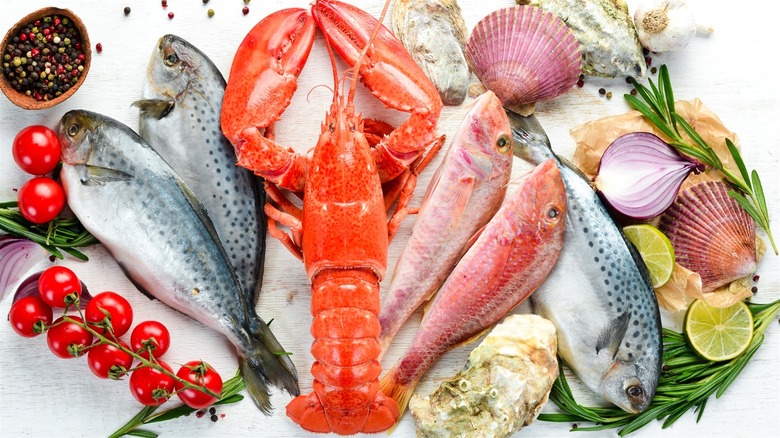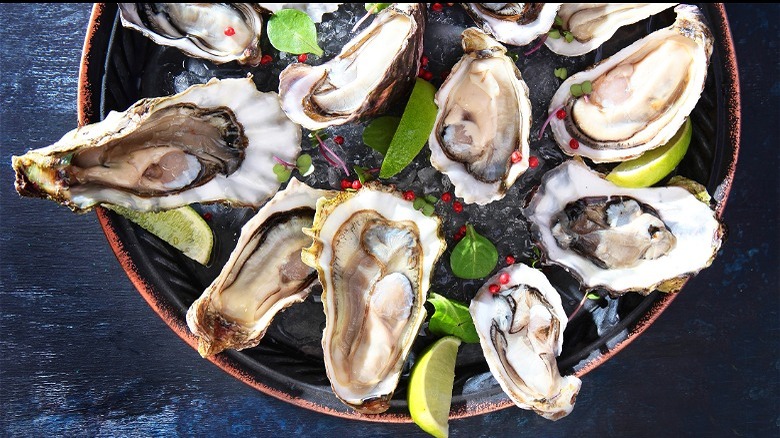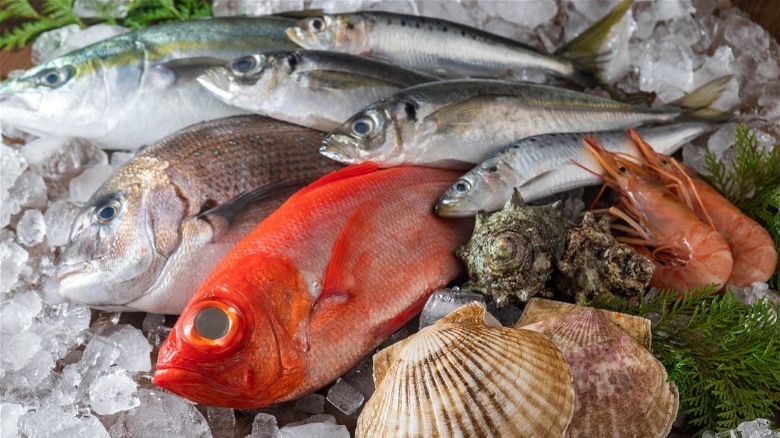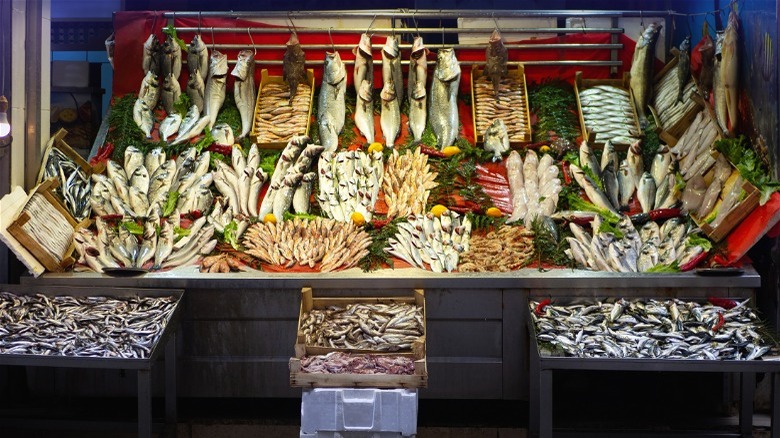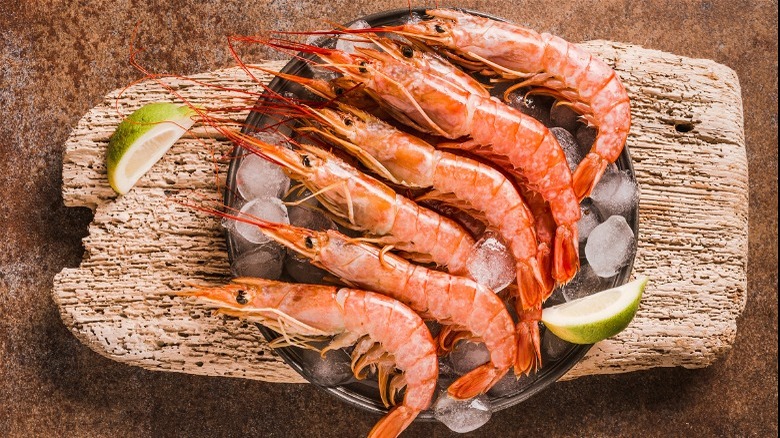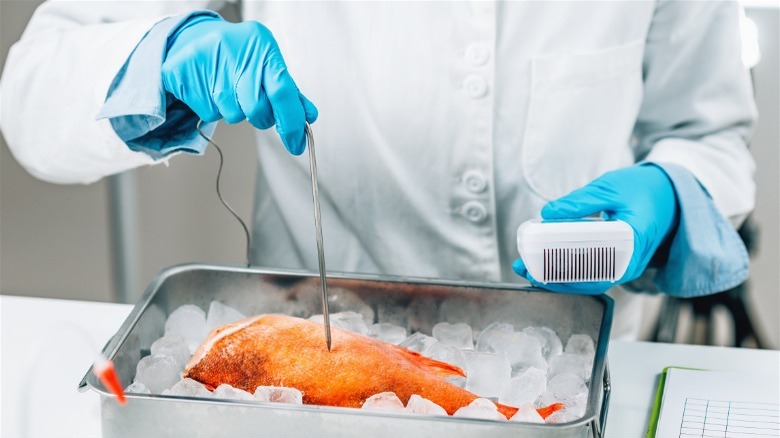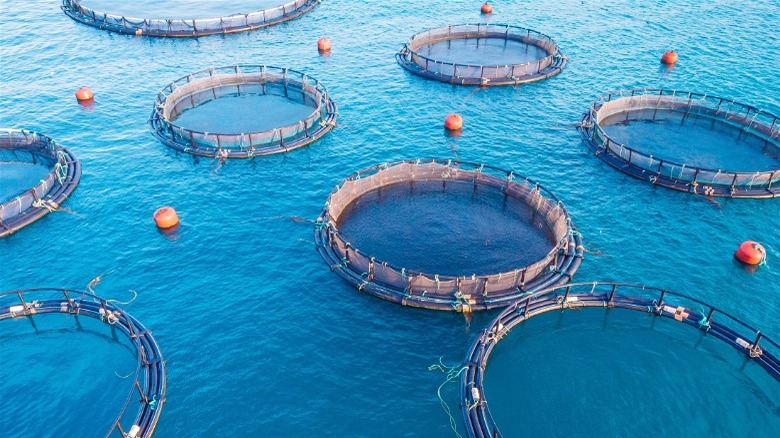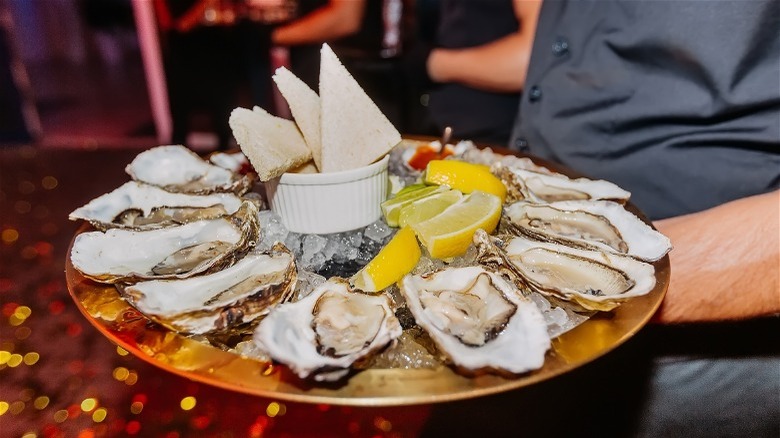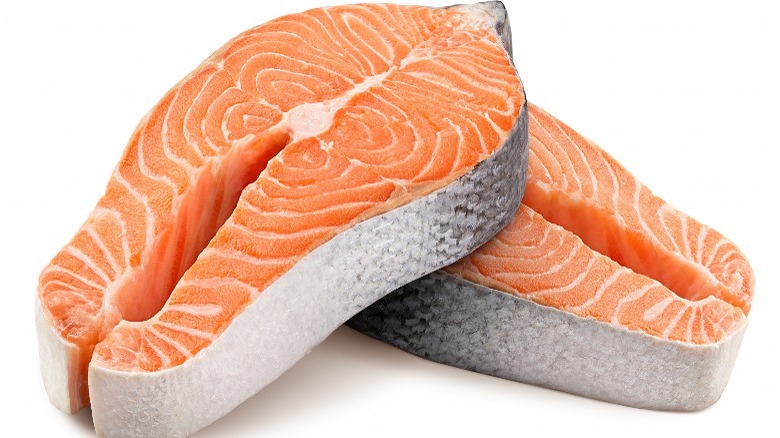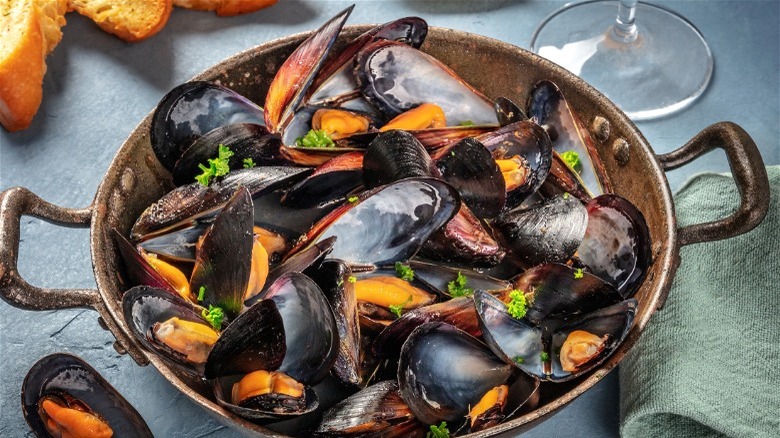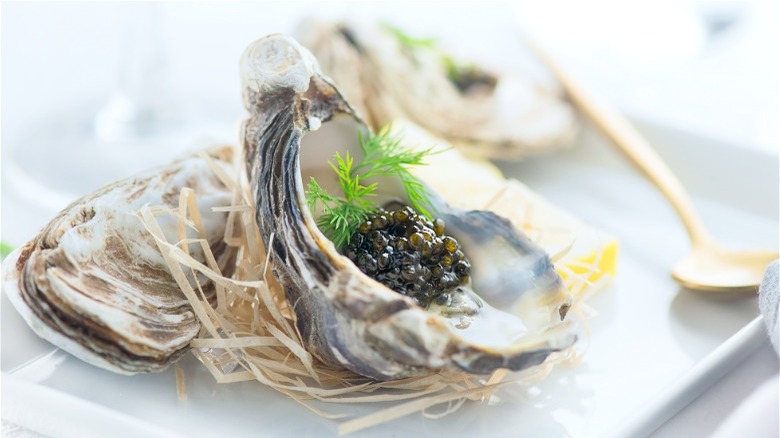Seafood Myths You Can Stop Believing
Seafood is a bonafide way to get flavor, convenience, and nutrients. Not only is it quite straightforward to find sustainably, but seafood is a great addition to a healthy diet, as many types of fatty fish contain high levels of omega-3 fatty acids, which are linked to reduced risk of heart attacks and strokes (via Everyday Health).
But with so many concerns around freshness, cooking methods, and the best seafood to buy, there seem to be more questions than answers. Widely-held myths have given some people the impression that seafood is trickier to select and prepare than it actually is. For instance, Is fresh fish better than farmed? Where is the best place to get seafood? And are there certain days (or months, even) that you should stay away from seafood?
If you've been intimidated by the supposed "rules" and have kept your distance from the seafood counter at the grocery store, you can set your fears aside. Here, we've debunked a few of the most common myths. Whether the myths are based on outdated information, they're just plain wrong, or they're impossible to prove, keep reading to find out which seafood myths you can finally stop believing.
Only order oysters during months that have the letter R
This piece of advice is rumored to help avoid belly aches. And surprisingly, it's now believed that avoiding shellfish during months that don't contain R is advice humans have been following for more than 4,000 years (via Science Daily). This rule of thumb which states that shellfish are only safe to eat from September through April is believed to have originated when modern refrigeration wasn't invented, so shellfish were likely to spoil if kept out in warm temperatures.
But, shellfish also spawn during the warmer months. The spawning process makes them soft and watered down, thus resulting in a less potent and fresh flavor (via Southern Living). This rule is also historically linked to red tide levels when the plankton population explodes to toxic levels. Consumption of shellfish that contains a specific bacteria (paralytic shellfish toxin) often found in red tide blooms can cause paralytic shellfish poisoning in humans (via ACSH). Red tide is more common where surface temperatures are warm, saltwater is low and seas are calm. Rest assured that most shellfish are farmed and harvested from cold-water regions, and shellfish-producing states have complex monitoring systems that ensure the commercially harvested shellfish is safe for human consumption (Mass.gov)
If you've been following this "rule," you've had to sit out from slurping down oysters four months per year, but if you're buying shellfish from a reputable establishment, oysters are more than safe for human consumption every month of the year.
Fresh is better than frozen
Consumers are constantly reminded of the fact that fresh is better than frozen. How else do you explain the lobster tank in the middle of the dining room of your favorite seafood restaurant? The appeal of fresh seafood is undeniable, especially if you've ever eaten fresh-caught seafood. So is fresh seafood always better than frozen?
This may not be the case. According to Epicurious, "freshness can be frozen." A few key things happen when you freeze fish; nutritionally, the fish stays the same, and you can lock in the freshness of the fish. So while it's always a treat to eat fresh-caught fish, there's not much difference when you eat high-quality frozen fish.
Buying frozen fish is also a solid way to ensure you're eating more sustainably and reducing waste. According to the Washington Post, the "fresh" fish in the seafood department may actually be several weeks old, and a lot of it might also be previously frozen.
It's more budget-friendly to buy frozen seafood because its long shelf-life means it's cheaper for grocery stores to stay stocked. So if you've been concerned that fresh is better than frozen, there are several reasons why you should try frozen if you haven't already!
Sustainable fish is only available at specialty markets
With the push to shop sustainably, consumers are often left confused about where to start. Thankfully, there are now plenty of apps and guides to help consumers make smarter decisions when strolling the aisles. The Environmental Defense Fund's Seafood Selector website has easy-to-navigate categories of best, okay, and worst seafood options. And it also breaks down mercury and eco-ratings for each type of fish.
There are likely many options for unsustainably-farmed seafood at your local grocery store, but if you know what questions to ask, you'll find some sustainable options there, as well. Of course, you can never go wrong with a specialty fish market, but if you do shop for seafood at the most convenient grocery store, you can use a guide to help you make the best choices for you and the environment.
Also, if you've used the guides to do your research, buying a specific type of fish from selective fisheries that have moved to a more sustainable method is a great way to shop sustainably. You can also try checking the origin of the fish you buy to keep your fish consumption local (via NPR). If you're willing to strike up a conversation with the person behind the fish counter at your local grocery store, you may discover a few gems.
Shrimp is high in cholesterol and therefore bad for you
Seafood is known as a key component of a healthy diet. With nutrients like omega-3s, protein, vitamins B and D, and iron, seafood can help strengthen bones and keep your heart and immune system healthy (via Seafood Nutrition Partnership).
But is all seafood created equal? Some seafood, shrimp, in particular, is known for its high levels of cholesterol. So are the crustaceans just as healthy, as, say a piece of grilled salmon?
When it comes to cholesterol, most animal protein has high levels. Shrimp has more cholesterol than most other types of seafood, but as registered dietitian and assistant professor of nutrition Robin Danowski told Women's Health, "dietary cholesterol only has a small effect on blood cholesterol." Compared to red meats and processed foods, shrimp's cholesterol content — 161 mg per 4-ounce serving — is minimal.
Shrimp is also often breaded and fried or served with buttery sauces, so if you're health-focused, that can be a major downfall. But on their own, they contain high doses of iron, iodine, phosphorous, niacin, and zinc, making them a nutrient-rich protein source.
All seafood contains dangerous levels of mercury
The concern about high mercury levels only pertains to certain types of fish. A few species, such as marlin, orange roughy, swordfish, and ahi tuna, are all known to have some of the highest levels of mercury, according to the National Resources Defense Council. This happens when coal-burning factories emit mercury into the environment and it works its way into large bodies of water. The mercury is absorbed by bacteria and is eaten by small fish. Then large fish eat the smaller fish, accumulating mercury in their systems.
The FDA recommends adults consume no more than 6-ounces of fish if caught by families and friends per week. But the safest way to ensure you're not getting too much mercury is to eat a variety of fish and to eat a range of sizes — like anchovies and scallops as well as tuna and salmon.
Mercury poisoning is more dangerous in children, so if you're an adult, you don't have too much to worry about. Simply pay attention to seafood advisories and avoid consuming only fish the types of fish listed as a higher risk. That said, children under 12, individuals who are pregnant, or those who are breastfeeding have to be more careful. These groups should stay away from raw fish (like sushi!) and limit consumption to one or two servings of seafood per week.
Farmed seafood isn't so bad.
When it comes to the myth "all farmed seafood isn't so bad," the real answer is, "it depends." Certain species of sea creatures, such as oysters, catfish, and scallops, are often more sustainable in their farmed state.
Today, many farmed fish are fed mostly vegetarian diets with protein like soy. In the past, they may have eaten smaller wild fish, throwing off local wild fish populations. According to the New York Times, farming is the only viable option to keep up with the demand for human seafood consumption, lest we completely drain the natural stock. Because there are so many kinds of farmed seafood, it's impossible to simply slap an approval label onto all of them.
Salmon is one example where wild-caught is almost always the better option. Wild-caught salmon contains lower levels of unsafe contaminants, cancer-causing chemicals, and risky pollutants while containing fewer calories and less saturated fat than farmed salmon (via Cleveland Clinic). Atlantic salmon is almost exclusively farm-raised, so by steering clear and sticking to solely wild-caught salmon, you may be able to keep your fish consumption sustainable (via Food Print).
This is one of those cases where you'll have to use your best judgment. Not all farmed fish is bad. And if you can locate a farm that uses a recirculating water system, it's much better for the fish and the environment.
Don't order seafood on Monday
When Anthony Bourdain's most conspicuous piece of advice became popular, it was a very different time. In his 1999 memoir "Kitchen Confidential," Bourdain instructed diners to stay away from ordering fish on Monday. It was the one nugget that most people, even burgeoning foodies, took with them to restaurants.
The idea behind the advice was that most restaurants were using last week's food. At the time in New York City hospitality, there were no fish deliveries over the weekend. And for something like seafood that relies on freshness, ordering fish on a Monday was a surefire way to end up with a less-than-stellar piece of fish. But he cleared up the advice in 2016 by explaining that the world has changed and the advice no longer applies (via Business Insider's Youtube Channel). The standards are higher, the variety is improved and gastronomy has advanced leaps and bounds in the years since Bourdain's book was released.
Bourdain left a lasting legacy since his death in 2018. That this advice is still popular, even if it's been debunked, proves just how much he impacted restaurant culture.
Salmon is fine to eat year round
Salmon appears on menus around the country as sushi and filets, no matter the time of year. Although modern technology has made it convenient for us to enjoy the foods we want, when we want them, should we still be eating our favorite fish year-round? The simple answer is that of course, you can eat salmon year-round. But if you're trying to eat more sustainably and want to stay away from farmed fish, you'll need to do more due diligence than just grabbing the first package of salmon you see at the grocery store.
Local fisheries set their regulations on salmon fishing season. They do this by using info from scientists, fishers, tribal representatives, and more. And of course, they factor in the abundance of wild salmon expected and provide enough time to give the fish time to spawn and replenish. This spawning and replenishment process is something that happens at different times of year in different parts of the world. So if you're eating salmon year-round, you're losing touch with its seasonality.
When shopping at a trusted fish shop or from a local fisher during the off-season, you're more likely to encounter fresh local salmon that has been frozen. Most of the salmon available in stores, however, is farmed and imported, according to Monterey Bay Fisheries Trust. Keeping a seasonality guide handy, like this one from Courier Post, can help you to know what time of year you can get the freshest salmon.
Unopened mussels are bad.
Part of the appeal of seafood is that it's so easy to cook. Most fish is fully cooked in under 10 minutes and shows very visible signs of doneness. Bivalves such as clams, mussels, scallops, and oysters, are just as simple to prepare. Ensure their shells are closed and there are no smells, then cook them as you wish!
But what happens if the shell is still closed after cooking? You may have heard that you should always ditch these unopened mussels, but that isn't necessary at all. You might be throwing away perfectly good mussels.
BBC Good Food recommends eating any mussel that is still closed but can be easily opened. If, however, the mussel is stuck or difficult to open, then it's likely still raw on the inside, which might not be so delicious. So use your best judgment, but all cooked and closed mussels are not created equal!
Oysters are an aphrodisiac
In Greek mythology, Aphrodite, the goddess of love, emerged from the sea in an oyster shell. And in the 18th century when Venetian Lothario Giacomo Casanova filled up on upwards of 50 oysters a day to prepare for his romantic trysts, a link between oysters and sexual prowess was firmly established.
The only problem is that this link has never been scientifically proven. There does seem to be a connection between testosterone production and zinc, of which oysters (and other bivalves) contain plenty (via New York Times). And one study identified amino acid D-Aspartic in mussels, which successfully increased hormone levels in lab rats. But what about oysters? The results seem to be inconclusive.
Scientists say desire is a lot more complex than just downing one food. And when your overall well-being is in a healthy place, your sexual desire also tends to increase. So, if you want to fill up on oysters to get in the mood, go right ahead. It won't do you any harm, but it also might not help.
